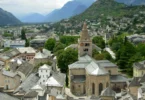
Introduction
The Basilica of Our Lady of Copacabana is a 16th-century Spanish colonial shrine that houses the image of the Virgen de Copacabana. It is located in the town of Copacabana, Bolivia on the shores of Lake Titicaca near the Altiplano region. Our Lady of Copacabana is the patron saint of Bolivia.
The Sanctuary of Our Lady of Copacabana, Patron Saint of Bolivia, stands majestically on the shores of Lake Titicaca, at about 3,850 meters above sea level and just 8 km. of the border line with Peru. To confirm the evangelization already begun in the vast plateau, Divine Providence inspired an Indian of royal blood to make an image of the Blessed Virgin Mary.
The current building was built between 1669 and 1679 by the Spaniard architect Francisco Jiménez de Siguenza replacing a small former church. It was originally administered by the Augustinians.
Constructed at the foot of a small steep hill, sacred to the Inca and known as the Temple of Sun, it remains as one of the two principal sacred places of importance to the indigenous peoples and Catholics alike. The other is the Virgin of Urkupiña near Cochabamba, Bolivia.
The Bolivian community in Argentina celebrates the Feast of the Virgin of Copacabana in Buenos Aires in October.
History of Our Lady of Copacabana, Bolivia
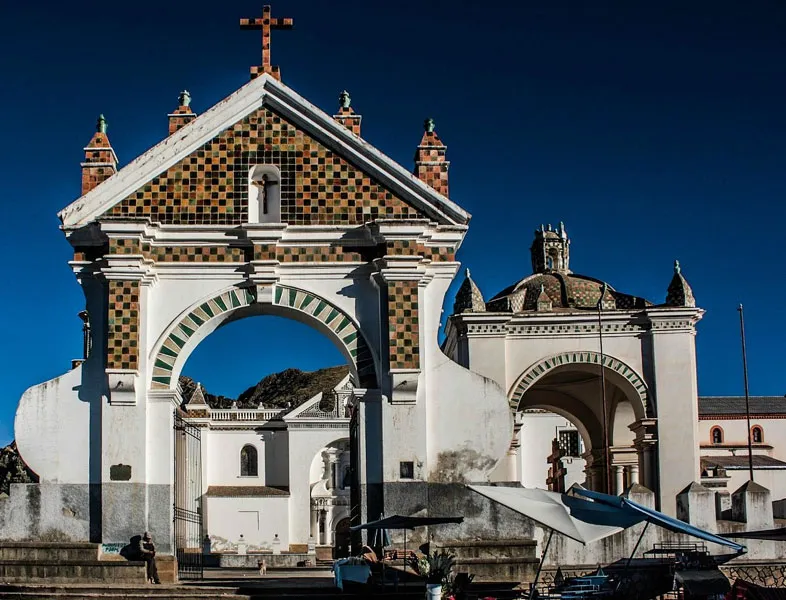
It is thought that the name originates from the name ‘Kotakawana’, the Andean god of fertility. This theory was backed up by the unearthing of a number of shrines in the area dedicated to the deity. This name was used by the indigenous people of the ‘altiplano’ for many centuries before being adopted by the Spaniards for the town we know today.
In the centre of the town the basilica of Our Lady of Copacabana, Bolivia, a 16th century Spanish colonial shrine, stands at the foot of a steep hill sacred to the Incas. Also known as the Temple of the Sun, it is one of the two remaining places in the country that is sacred to both Catholics and the indigenous people alike. The shrine houses the image of the Virgen of Copacabana, also known as the Virgen de la Candelaria, the patron saint of Bolivia.
When the Spaniards arrived in Bolivia, the indigenous people’s religion involved the worshipping of the sun, moon and stars. The conquistadores brought with them their campaign of colonisation and conversion to Christianity.
The Incas believed that the world was created at Lake Titicaca and therefore the lake and its shores were long considered to be sacred. When the Spaniards tried to convert the local people to Christianity they found resistance and the transition was more difficult than they had expected.
In addition to the more brutal techniques used to convert the indigenous people, the Spaniards decided not to destroy ‘pre-Christian’ holy places and instead to convert them to places of Christian worship in the hopes that the people would willingly come to the places they already knew and begin to worship the Christian God. They also added symbols of the sun, the moon and stars to Catholic images, making these statues more familiar to the local people.
In the late 1500s a local fisherman, who was a devout Catholic but also a descendant from the original Incan emperors, decided to build a statue of the virgin for his hometown. The efforts of this inexperienced sculptor were initially rejected and he decided to travel to the south of Bolivia to study the art of sculpting under some of the finest artists in the country. Eventually he carried his finished statue for over 640 kilometres to Copacabana, on foot, and it was humbly enshrined in a poor adobe church.
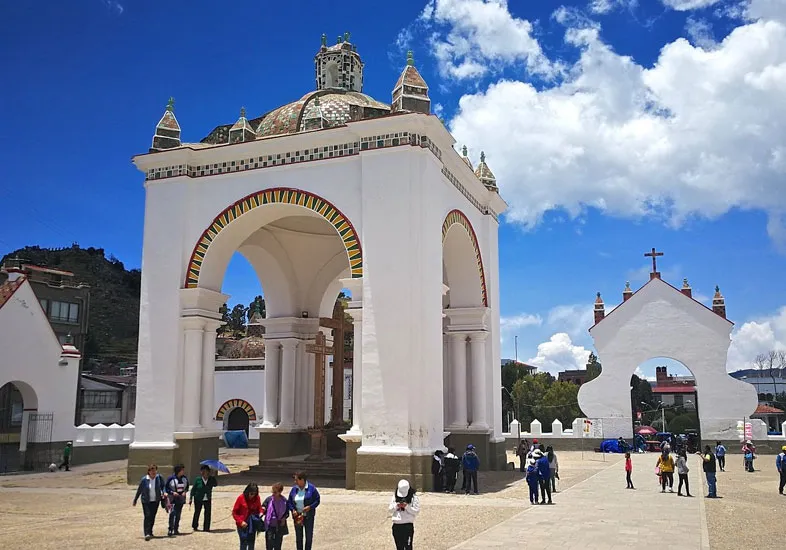
Not long after the statue arrived in the town, a group of local fishermen were caught in a powerful storm on the lake. They prayed for their lives and later told the story of the virgin appearing to them and guiding them safely ashore. Soon more miracles were attributed to the statue and the great basilica, which was completed in 1805, was built to house the Virgin of Copacabana.
Today, it is one of the most visited pilgrimage sites in Bolivia. In the Capilla de Velas, people burn candles and use the wax to write or draw their wishes on the walls. This practice is still popular today, despite the signs on the walls asking visitors not to do so.
The basilica has also become a popular site for car blessings. The ceremony takes place every morning at 10:00 am and cars line up around the plaza. The cars are adorned with flowers, petals and colourful decorations and the priest blesses each one with holy water for safe travels.
In April 2013, the basilica was broken into and the image of the virgin was stripped of her gold and silver accessories. The sculpture of baby Jesus was also taken.
Architecture of Our Lady of Copacabana, Bolivia

Architectural Style: Renaissance
From its beginning, the image gained a reputation for being a miracle. The Augustinians built their first chapel between the 1614 and 1618, and later, the Viceroy of Lima, Conde de Lemos, morally and financially supported the construction of a basilica to honor the Virgin. Construction of the Basilica of Our Lady of Copacabana began in 1668, was inaugurated in 1678, and was completed by 1805. Subsequently, the faithful donated embellishments to the image, including valuable jewels, and the temple was filled with gifts and treasures.
In 1825, when Bolivia gained independence, it was attributed to the faith of the population through the Virgin of Copacabana. However, in 1826, Marshal Antonio José de Sucre, the President of the Republic of Bolivia, expropriated all the jewels and colonial treasures at the Shrine of the Virgin, using them to create the first coins from Bolivia.
Virgen de Copacabana (Our Lady of Copacabana)
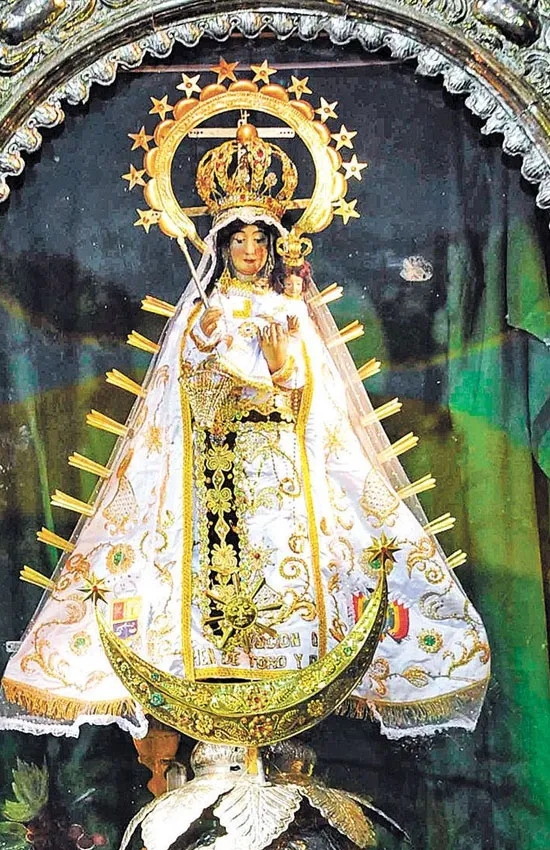
The Virgen de Copacabana (Our Lady of Copacabana) is the patron saint of Bolivia. She is venerated in Bolivia during her feast day of 2 February, the day of the Purification of Mary, or feast of the Virgen de la Candelaria. She is also venerated on 5 August with her own liturgy and popular celebration.
Pope Pius XI granted the image a decree of Canonical coronation on 29 July 1925 and was crowned on 1 August the same year.
Among the passengers of a ship lost in a storm near Rio de Janeiro, were some Brazilian pilgrims returning from a visit to the shrine of the Virgin of Copacabana in Bolivia. They called upon the Virgin to intercede for them, and, they were landed safely on the Brazilian shores. In token of gratitude, they called the spot Copacabana – and it has since become one of the world’s favorite resorts.
In Bolivia, however, the original Copacabana does not suggest joyful social life; it spells a wonderful story of faith and love. Enclosed by beautiful sloping mountains overlooking the Mary-blue of Lake Titicaca, lies the tiny cove called Sepa-cabana or Copacabana. The name means “one who looks at the precious stone,” because in the distance, lovely to see, stretches the majestic, ice-capped necklace of the Cordillera of the Andes. In this spot in the days of the Inca Empire, lived good Indians whose sole duty was to prepare for journeys of worshippers to the Island of the Sun, some miles out on the lake. Copacabana, accordingly, became the center of much Incaion activity, for the Incas were fanatic in their visits to the island shrine.
The missionaries who came with the Spanish conquerors naturally planted the cross in all large Incan centers, and a church was built in Copacabana. It was dedicated to St Ann. However, The Mother of the Blessed Virgin seemed to frown on this honor, for the town soon fell into disrepute and the harvests were poor. Many of the Indians moved away until only a few souls remained. Those who stayed believed that if the town were dedicated to some other saint, the town might prosper; but the agreement on the identity of the new patron could never be reached.
History of Our Lady of Copacabana
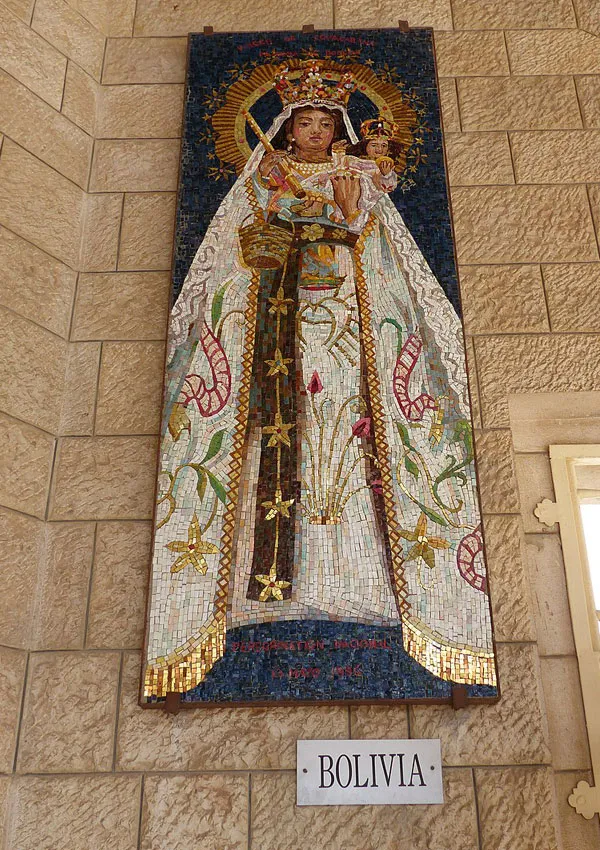
In the year 1581, a young Indian lad, Francisco Yupanbi, desired earnestly that his town be dedicated to Our Lady. In secret he started to construct a statue of the Virgin and Child to be presented to the village. For more than a year he labored day and night. When he called in the townspeople to see the result, they laughed at him in scorn, for Francisco knew nothing of art, and his statue proved it. Undaunted, but burning with the desire to complete the task, the youth went off to visit all the great cities of Bolivia in order to study under the masters who were decorating churches and monasteries.
Finally after months of disappointments and successes, he finished his labor of love, Our Lady of Copacabana – a Virgin with all of the features of his own race, in her arms an Infant no different than the thousands of Indian Babies Francisco had known so well. He called in his teachers and other artists, and they were astonished; he had created a veritable work of art; but for him it was a labor of love, representing his “Little Mother,” the Virgin who could save his native town of Copacabana. He hastened with his precious burden to his home; but as he arrived, he was met by a delegation of citizens, who had come to drive him and his silly lump of plaster away.
But the Virgin, Our Lady of Copacabana, smiled on Francisco; when the box was opened the hostile attitude changed; when they saw the love that had been caught in the face of the Madonna, they welcomed Francisco and his dear burden to the town. There were soon many miracles attributed to devotion to the new statue of Our Lady of Copacabana. The warmth of love engulfed Copacabana, and soon a church was built for the Mother and her Child. Jewels from devout persons far and near poured into the shrine to adorn Our Lady of Copacabana; distant pilgrims came day after day.
Francisco entered a monastery where he died a happy, holy man. Many legends grew up around his statue; it is said that if you look at her and think her beautiful, that is a sign that you are in her favor; if not, your soul is ugly. Many cures and miracles have been attributed to this Virgin, the greatest, that of faith – she stands as a monument of the faith of Francisco Yupanbi and to the faith of the millions of Indians who came after him; of poor and rich, mighty and lowly, who have revered this simple piece of clay that reminds them of their “Mamita,” the little Mother of everyone. The Blessed Virgin Mary is the patron saint of Bolivia, and the shrine of Our Lady of Copacabana is one of the oldest shrines in the Americas.
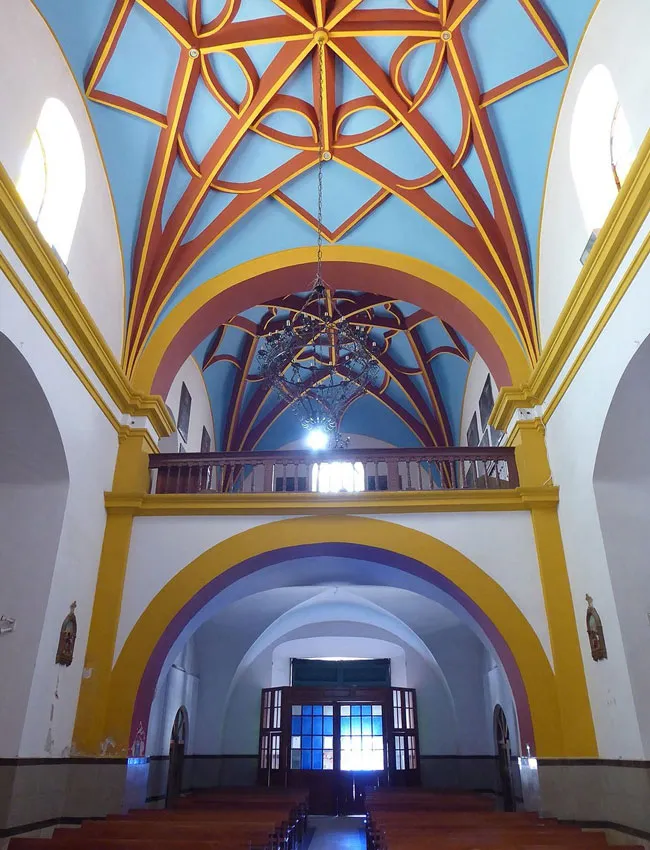
Carving Description
The body of the image measures about four feet, carved in maguey wood and is laminated in gold leaf. The clothes are that of an Inca princess. The form is covered with luxurious robes and dresses, and wears a wig of long, natural hair. It holds the Child Jesus in a peculiar position, as if about to fall. In her right hand, she holds a basket and a gold baton, a gift and souvenir of the visit in 1669 from the Viceroy of Peru.
The original image never leaves the sanctuary; a copy is used for processions. Those leaving the shrine walk backwards with the intention not to turn their backs on the Virgin.
Nerdio
The hilltop overlooking Lake Titicaca was rededicated as a “calvario” or replica of Calvary and is topped by the Stations of the Seven Sorrows of Mary and an altar with a depiction of the crucifixion of Jesus. It is a major centre of worship throughout the region during Holy Week, especially on Good Friday and Easter Sunday.
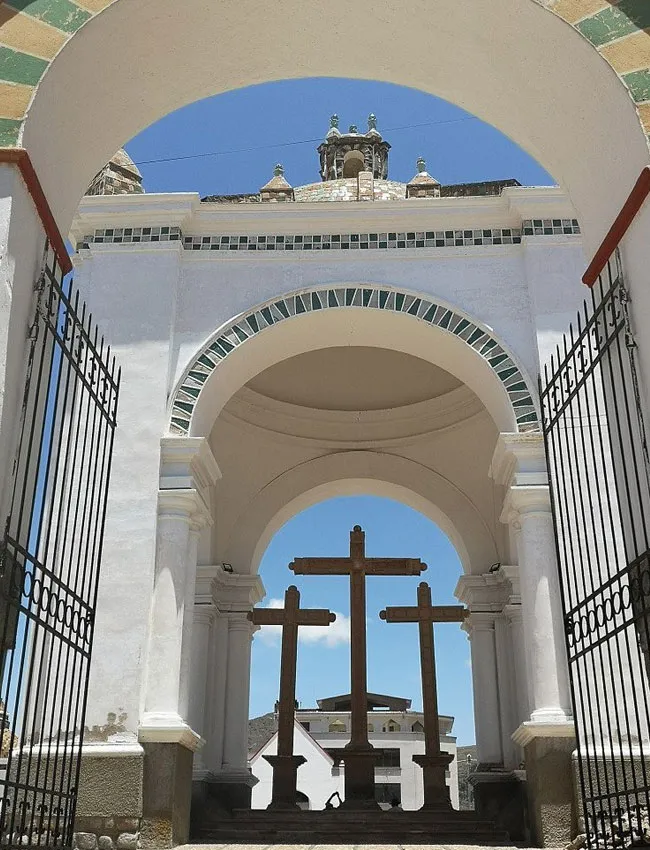
Epilogue: Copacabana Today
For a few decades, commerce has taken over Copacabana, which has vigorously expanded around the Sanctuary. The city has all the basic services and even luxury hotels have been installed in its vicinity. But the main reason that still drives countless pilgrims to this sacred site is still the cult of the Virgen del Lago.
With the proliferation of modern tourism and the actions of indigenous NGOs, Copacabana today faces the indifference of some and the attempt of others to revive the old paganism. Useless challenge for She who a thousand times stepped on the head of the infernal serpent.
Virgo Singularis (A Singular Image)
The Virgin of Copacabana is a maguey wood carving. It measures with the pedestal just over a meter high. The body of the image is completely laminated in fine gold, and the polychrome resembles the clothing of a coya (Inca princess). She is always dressed in beautiful and colorful cloaks offered by her devotees, and on her long wig of natural hair she wears a crown of great value, a symbol of her royalty.
With her left hand, the Virgin hugs her Son in a very peculiar way, as if he were about to fall, and with her right hand she holds the offering basket and the candle. In the sweet face of her and that of the Child the indigenous features of the inhabitants of the region are reflected. A large crescent under her feet reminds us of her eternal victory over the devil and her minions. Among the rich jewels that adorn it, stands out the baton that was given to her by the pious Viceroy, Venerable D. Pedro Antonio Fernández de Castro, Count of Lemos, as a souvenir of her visit in 1669.
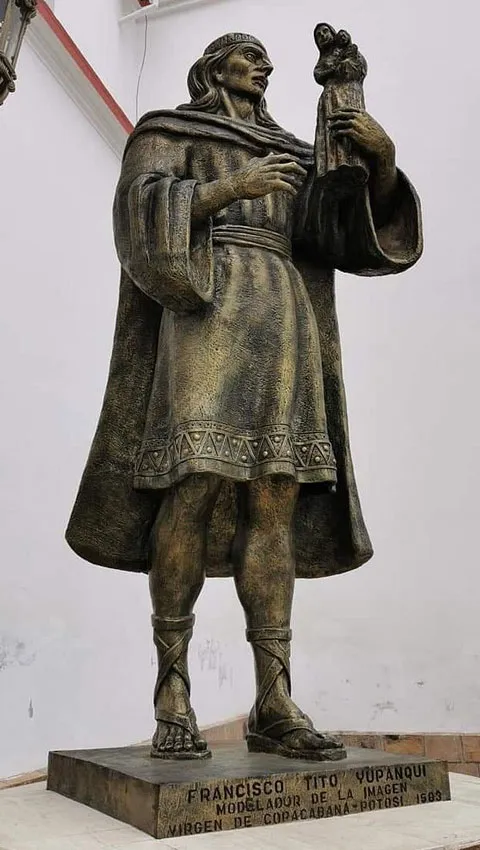
Feast Day - 2nd February
The Feast of Candelaria is a holiday and the beginning of a festival that begins on the 2nd day in February. It venerates the Virgen de Copacabana, also known as the Blessed Virgin of the Candelaria, who is the patron saint of Bolivia.
The central focus of this holiday is the Bolivian town of Copacabana although veneration of the Virgin is performed all over the country. On February 2nd, there are a variety of religious services and festivals associated with this holiday.

Contact Info
Basilica of Our Lady of Copacabana,
Bolivia on the shores of Lake Titicaca,
Near the Altiplano Region,
Copacabana, Bolivia.
Phone No.
Tel : +591 2 8622081
Accommodations
How to reach the Basilica
El Alto International Airport serving La Paz, Bolivia is located in the city of El Altois which is the nearby airport to the Basilica.

